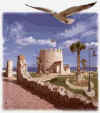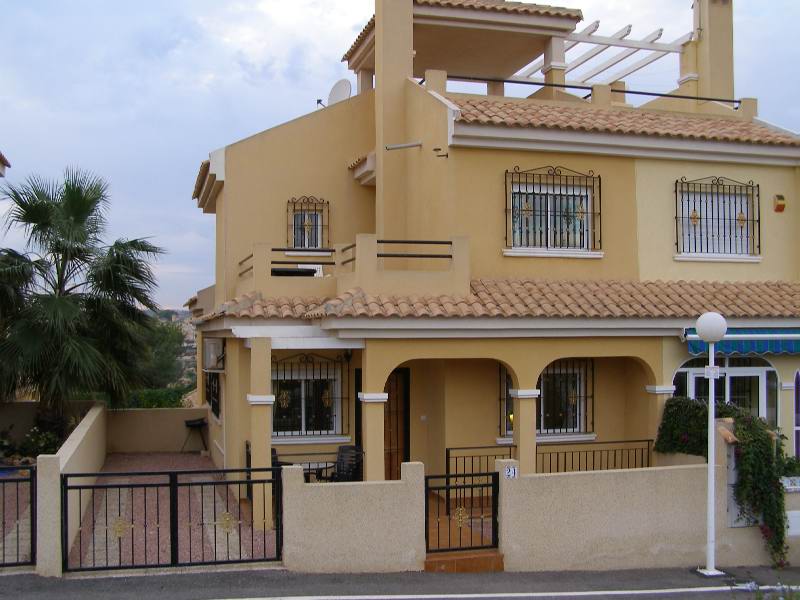|
|
Torrevieja presents a fine combination of tourist attractions and business
from its salt flats. Found here is the La Mata y Torrevieja Lagoon nature park,
a unique area in which the age-old tradition of salt mining has now successfully
been combined with concerns for conservation of local marshlands and nesting
sites for MIGRATORY birds, all in a highly attractive enclave The coast along Torrevieja, with its seafront promenade, clean beaches,
and modern yacht club with a full range of services and tourist
installations, offers one of the most attractive tourist destinations along
the southern coast of the Land of Valencia
Spain
| Month |
Jan. |
Feb |
Mar |
Apr |
May |
Jun |
Jul. |
Aug |
Sep |
Oct |
Nov |
Dec |
Average temperature
(en º C) |
16 |
16 |
16 |
20 |
20 |
23 |
27 |
27 |
24 |
21 |
16 |
14 |
|
 |
Situated on the Costa
Blanca approximately one hours drive South from Benidorm and 40 minutes
from Alicante airport, Torrevieja nestles between the Mediterranean sea
and two large salt lakes. A predominantly Spanish
holiday resort, Torrevieja has all the facilities you would expect yet still
retains a relaxing friendly atmosphere.
|
| The Costa Blanca
literally means the white coast, the beaches in and around the Torrevieja
area prove this to be true. There are numerous sandy beaches
and coves to choose from. |

|
|

|
The beautifully restored old
church square is favourite meeting point for locals and tourists alike. |
| Holiday makers take a dip in the
refreshing Fonts D Algarve just an hour from Torrevieja. This picturesque
area is close to Benidorm and the new Terra Mitica theme park. |

|
| Bathers
enjoy one of Torrievieja's two new sea pools right in the town
centre late in
September. |

|
|

|
The newly restored fountain
and mosaic seats in one of the town squares |
| During
the day Torrevieja also offers a range of leisure and entertainment
areas. As well as its beaches and numerous terraces along its maritime
promenade, its great aquatic park (Aquópolis) is swarming with
families, young people and children during the summer months. |
 |
|
|
If you
prefer to contemplate and enjoy the Alicante coastline, there is no
better way than by going on a trip on the Tabardo cruisers equipped with
catamarans in which you can observe the sea bed. Excursions to the
island of Tabarca and trips all along the coast of southern Alicante
round off this interesting and unique tourist provision. |
|
Finally, for the lovers of ecological and environmental tourism, you will
not do better than visit the lakes of La Mata and Torrevieja to enjoy a
mudbath, recommended by doctors around the world for its curative properties
for a large number of rheumatic dermatological, heart and respiratory
complaints. |
|

|
|

|
The salt and the
sea are the inseparable elements which have marked the history and determined
the present-day reality of Torrevieja. At the beginning of the last century
there was only a watch-tower, the old tower and a few houses. In 1802 the La
Mata salt-flat offices moved to the present site, bringing about the rapid
urbanisation of the former Torrevieja. The proximity of the slat-flats and it
being an exporting port both of salt and the horticultural produce of La Vega
Baja led to the growth of port and town, which gained its independence from
Orihuela in 1820. Today it produces about a million tons of salt, mostly
exported, making it the prime European salt-producer. The International
Competition of Habaneras and Choirs, of International Tourist interest, is
held in homage to the people of Torrevieja who traded with Cuba, the former
Spanish colony and homeland of the Habaneras which the sailors sang on their
return. Salt and sea are the two inseparable elements that have marked the
history and determined the present-day circumstances of Torrevieja. At the
start of the 19th century in the town's current location there was only a
watchtower, an old tower and a handful of houses. In 1802 the administration
of the Mata salt-flats transferred to its current location and brought about
the rapid urbanization of Torrevieja. The proximity to the salt-flats and its
position as a port exporting salt, fruit and vegetables produced in the Vega
Baja of the Segura River resulted in the rapid development of the port and the
city. It gained its independence from Orihuela in 1820.Today it is one of the
leading European producers of salt, with approximately one million tonnes each
year, mainly for export. The International Habaneras and Choral Song
Competition, which has been declared to be of special interest to foreign
tourists, is held in honour of the inhabitants of Torrevieja who traded with
Cuba, a former Spanish colony and home to the Habaneras sung by the sailors on
their return. The lakes have been declared a Nature Reserve due to their
wetland ecosystem and for the ecological habitat they provide for migratory
and nesting birds. Modern day Torrevieja has other significant features
including the Modernist Casino and the Church of the Immaculate Conception
which are located in one of the commercial and residential areas of the town
respectively. In this area can also be found the monument to the Coralista and
the Museum of the Sea and of Salt, which explains the history of the sea and
of the salt industry which are representative of Torrevieja's past. Walks can
be taken to the fishing wharf and boat trips taken along Torrevieja's
coastline. There are several magnificent sandy beaches including Los Locos, El
Acequión, Los Náufragos, La Mata and El Cura. The southernmost beach, the Náufragos
beach, offers a range of amenities. The Cura beach is situated between the
Levante dock and the Punta Carral. Across from the Punta Carral is the Los
Locos beach. The longest and most northern beach is the la Mata from where
excursions can be made to the tourist vantage point of the Moro Tower, one of
the medieval towers that give Torrevieja its name.
|
Price per week 2014/
euros
|
Jan-29 march |
270 |
|
30Mar-26Apr |
330 |
|
27Apr-28June |
390 |
|
29June-27Sept |
490 |
|
28Sept-22Dec |
330 |
|
23Dec-5Jan |
390 |
|
Clean and linen |
65 |
email
|

